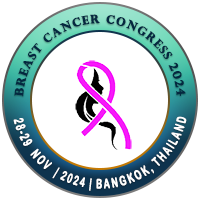9.jpg)
Kawthar Alajmi
University of Technology and Applied Sciences, OmanTitle: Development of breast cancer risk prediction models using the UK Biobank dataset
Abstract
Background
Personalized BC risk models based on modifiable factors can help to increase BC awareness. As a sequence the aims for this project are: a) to review BC risk models, b) to review the published BC risk factors, c) to assess the BC risk factors of the UKBiobank, d) to explore the effects of “healthier lifestyles” with different genetic predispositions, and e) to develop BC risk prediction models based on UKBiobank cohort.
Methods
PRISMA was used for the review. Then, literature was reviewed and summarized. Later, UKB data was analyzed using glm to derive 95%CI of RR. Then, hazard ratios were calculated based on genetic predisposition score (305 SNPs). Finally, backward stepwise logistic and bootstrap regression were used to derive the best fitting.
Results
14 epidemiological models were identified. All models were well calibrated but had poor discrimination in internal validation. However, external validation was missing for most of models. A list of modifiable risk factors, partially modifiable, non-modifiable were evaluated. Additionally, these risk factors: age, height, BMI, waist to hip ratio, first degree family history of BC, early menarche, null-parity, late first livebirth, high reproductive interval index, long use of OC were all significantly associated with increased BC among pre-menopausal. While among post-menopausal, age, height, high BMI, first degree BC family history, null parity, late first livebirth, high reproductive interval index were significantly associated with increased BC risk.
Moreover, analysis showed potential BC risk reduction based on selected factors (more exercise, healthy weight, low alcohol, no OC or no or limited HRT). The results were significant even if women had high genetic risk.
Finally, two epidemiological models based on menopausal status were developed (as absolute 5years risk). Later, the discriminatory power was significantly improved by adding a PRS as a risk score for BC in the extended genetic models.
Conclusions
The work can be used for a) increasing awareness, b) adapting healthier lifestyle, c) as an educational tool, d) attending the screening invitation.
Biography
To be updated soon.

